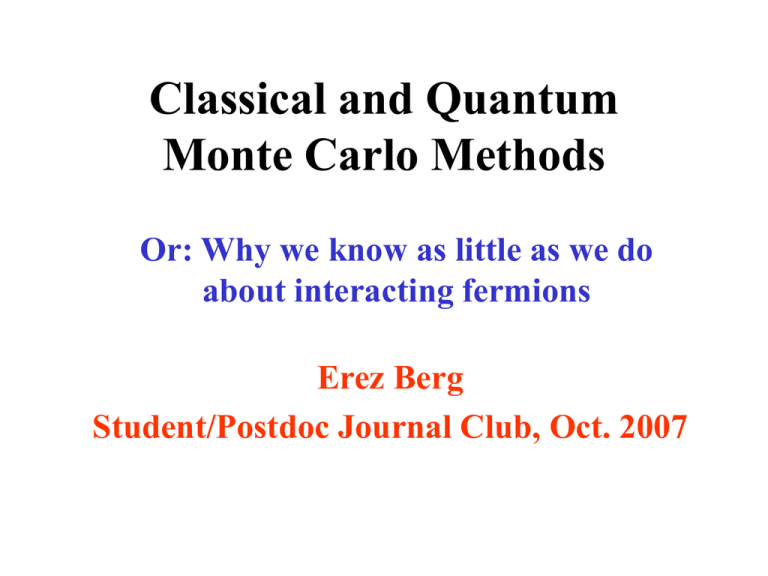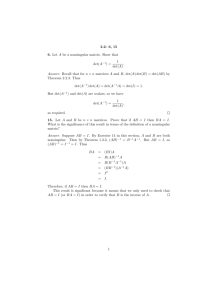Classical and Quantum Monte Carlo
advertisement

Classical and Quantum
Monte Carlo Methods
Or: Why we know as little as we do
about interacting fermions
Erez Berg
Student/Postdoc Journal Club, Oct. 2007
Outline
• Introduction to MC
• Quantum and classical statistical
mechanics
• Classical Monte Carlo algorithm for
the Ising model
• Quantum Monte Carlo algorithm
for the Hubbard model
• “Sign problems”
Introduction: Monte Carlo
Monte Carlo, Monaco
www.wikipedia.org
Introduction: Monte Carlo
Suppose we are given the problem of calculating
S
10000000
i 1
ai
And have nothing but a pen and paper.
“Monte Carlo” solution:
… And we may need to
sum much fewer numbers.
i=
Statistical mechanics
Z Tre
Thermodynamic
quantities
F 1 ln Z
F
F
CV T 2 2 , M
,...
T
H
2
Hˆ
Correlation
functions
1 ˆ Hˆ
ˆ
O Tr Oe
Z
Statistical mechanics
Example: Classical Ising model
Hˆ { 1 ,..., N } J i j
ij
Problem: calculate
1 k
1
Hˆ {1 ... L }
1 k e
Z 1 ... L
2D lattice with 10x10 sites:
Number of terms = 2100=1030
On a supercomputer that does 1015
summations/sec, this takes 107 years…
Stochastic summation
S f { }
{ }
f { }
f
Trick: write S
P{ }
P
{ } P{ }
P
P{ } Is an arbitrary probability distribution
Pick N configurations { }1...{ }N randomly
with probability P{ }
Calculate
1
S
N
i 1... N
f { }i
P{ }i
Stochastic summation (cont.)
Mean and standard deviation:
(Central limit theorem)
f { }i
1
f
S
N
N i 1... N P{ }i
P
std{S }
S S
2
P
1
f
std
N
N
P
S for any choice of P.
So… S
N
How to choose P?
Importance Sampling
f
We should choose P such that std is minimized.
P
f
For example, if P f , then std 0 !
P
… This is a cheat, because to normalize P we need to
sum over f.
But it shows the correct trend:
choose P which is large where f is large.
Sampling Technique
Back to the Ising model:
A natural choice of P:
1 k
1
Hˆ {1 ... L }
1 k e
Z 1 ... L
P{ }
e
Hˆ { }
Z
How to choose random configurations
with probability P{ }?
Solution: Generate a Markov process
that converges to P{ }
The Metropolis Algorithm
“Random walk” in configuration space:
{ }1 { }2 { }3 ...
1. Start from a random configuration { }1
2. Pick a spin j. Propose a new configuration
{ }' that differs by one spin flip
3. If P{ }' P{ }1 , accept the new
configuration: { }2 : { }'
4. If P{ }' P{ }1, accept the new configuration
with probability P{ }'/ P{ }1
5. And back to step 2…
Outline
• Introduction to MC
• Quantum and classical statistical
mechanics
• Classical Monte Carlo algorithm for
the Ising model
• Quantum Monte Carlo algorithm
for the Hubbard model
• “Sign problems”
Quantum statistical mechanics
Z Tre
Hˆ
…But now, H is an operator.
In general, we don’t even know how to calculate
exp(-H).
Example: Single particle Schrodinger equation
Hˆ
2
2m
2R V R
Quantum statistical mechanics
Path integral formulation:
Z Tre
Hˆ
Tre
Hˆ
e
Hˆ
....e
Hˆ
2
m
... DR exp d R V R
0 2
Discrete time version:
2
P / m( Ri 1 Ri )
Z dR1...dRP exp
V ( R)
2
i 1
P
ri ,1
2
1
P
ri , 2
The Hubbard Model
1
1
†
ˆ
H t ci c j H .c. ni U ni , ni ,
2
2
ij
i
i
•“Prototype” model for correlated electrons
•Relation to real materials: HTC, organic SC,…
•No exact (or even approximate) solution for D>1
How to formulate QMC algorithm?
Determinantal MC
Hˆ Kˆ Vˆ
Kˆ t ci† c j H .c. ni
ij
i
1
1
ˆ
V U ni , ni ,
2
2
i
Z Tre
Hˆ
Tre
Hˆ Hˆ
e
....e
Hˆ
Trotter-Suzuki decomposition:
e
Hˆ
e
Kˆ Vˆ
e
O
2
Blankenbecler, Scalapino, Sugar (1981)
Determinantal MC (2)
Z Tr e
Kˆ Vˆ
e
e
Kˆ Vˆ
e
....e
Kˆ Vˆ
e
The K̂ term is quadratic, and can be handled exactly.
What to do with the Vˆ term?
Hubbard-Stratonovich transformation:
e
1
1
U n n
2
2
1
e
2
1
U
4
e
s n n
s 1
cosh eU / 2
Note that this works only for U>0
Determinantal MC (3)
Hubbard-Stratonovich transformation for any U:
e
1
1
U n n
2
2
1
e
2
1
U
4
cosh e
e
1
1
U n n
2
2
e
s n n 1
U<0
s 1
U / 2
1 14U
s n n
e
e
2
s 1
U>0
Determinantal MC (4)
For the U>0 case, the partition function becomes:
Z e
1
Ld U
4
Here
Tr e
sik
ci† Kij c j
e
ij
ci†Vij 1c j ci† Kij c j ci†Vij N c j
ij
e ij
.... e ij
†
†
†
c
K
c
t
c
c
H
.
c
.
c
i ij j i j
i ci
ij
ij
i
†
c
i Vij k c j sik ni, ni,
ij
k+1
k
k-1
i
sik
i
i+1
Determinantal MC (5)
Now, since the action is quadratic, the fermions can be
traced out.
Tr e
ci† Aij c j
det 1 e
Aij
ci† Aij k c j
Aij k
Tr e
det 1 e
k
k
Z e
1
Ld U
4
det M s det M s
sik
M , sik 1 e
k
ik
K V , sik
e
ik
Monte Carlo Evaluation
Z e
1
Ld U
4
det M s det M s
sik
ik
ik
And, by a variation of Wick’s theorem,
Oˆ
O s det M s det M s
det M s det M s
Hˆ
ˆ
Tr Oe
Tr e
Hˆ
ik
ik
ik
sik
sik
ik
ik
How to calculate this sum?
Monte Carlo: interpret
det M det M
Z
as a probability P{s}
Sign Problem
Problem:
det M det M
is not necessarily positive.
Z
Solution:
det M det M sgn det M det M
Probability distribution:
Oˆ
P s
det M det M
Z
O s sgn
sgn
P
P
And evaluate the numerator and denominator by MC!
Sign Problem (2)
But…
At low temperatures and large U, the
denominator sgn P becomes extremely
small, causing large errors in Ô .
4x4 Hubbard model (Loh et al., 1990)
Sign Problem (3)
Note that for U<0,
det M det M
Therefore det M det M 0
And there is no sign problem!
Summary
• “Sign problem free” models can be considered as
essentially solved!
• In models with sign problems, in many cases, the low
temperature physics is still unclear.
• Unfortunately, many interesting models belong to the
second type.
No sign problem
Sign problem
Hubbard model (U<0)
Hubbard model (U>0): generic
filling
Hubbard model (U>0): half
filling
Heisenberg model, triangular
lattice
“Bose-Hubbard” model (any U)
Most “frustrated” spin models
Heisenberg model, square lattice
Summary
Quoting M. Troyer:
“If you want you can try your luck: the
person who finds a general solution to
the sign problem will surely get a Nobel
prize!”
References
•M. Troyer, “Quantum and classical monte carlo algorithms,
www.itp.phys.ethz.ch/staff/troyer/publications/troyerP27.pdf
• N. Prokofiev, lecture notes on “Worm algorithms for classical
and quantum statistical models”, Les Houches summer school
on quantum magnetism (2006).
•R. R. Dos Santos, Braz. J. Phys. 33, 36 (2003).
•R. T. Scalettar, “How to write a determinant QMC code”,
http://leopard.physics.ucdavis.edu/rts/p210/howto1.pdf
•E. Dagotto, Rev. Mod. Phys. 66, 763 (1994).
•J. W. Negele and H. Orland, “Quantum many particle
systems”, Addison-Wesley (1988).



